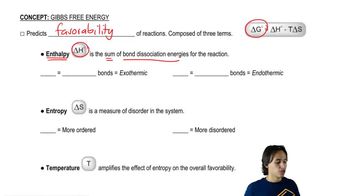Here are the essential concepts you must grasp in order to answer the question correctly.
Equilibrium Constant (K_eq)
The equilibrium constant (K_eq) is a numerical value that expresses the ratio of the concentrations of products to reactants at equilibrium for a given reaction. It provides insight into the extent to which a reaction proceeds, with values greater than 1 indicating a tendency towards products, and values less than 1 indicating a preference for reactants.
Recommended video:
The relationship between equilibrium constant and pKa.
Gibbs Free Energy (∆E)
Gibbs free energy (∆E) is a thermodynamic potential that measures the maximum reversible work obtainable from a thermodynamic system at constant temperature and pressure. In the context of chemical reactions, a negative change in Gibbs free energy indicates that the reaction is spontaneous, while a positive change suggests non-spontaneity.
Recommended video:
Breaking down the different terms of the Gibbs Free Energy equation.
Temperature (T) and the Gas Constant (R)
Temperature (T) in the equation is typically expressed in Kelvin, and it influences the kinetic energy of molecules, affecting reaction rates and equilibria. The gas constant (R) is a proportionality constant that relates energy scales in thermodynamics, with a value of 8.314 J/(mol·K). Together, T and R are crucial for calculating K_eq using the relationship with Gibbs free energy.
Recommended video:
Why we use pKa instead of pH.







